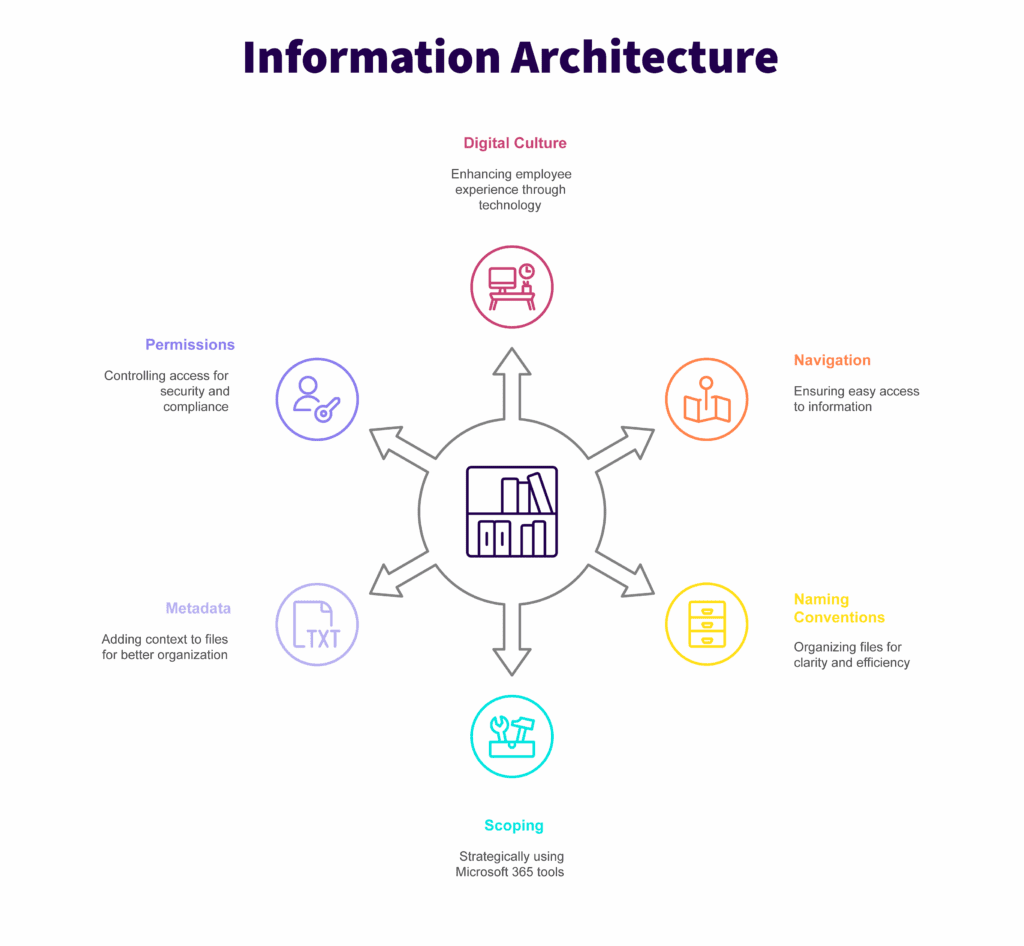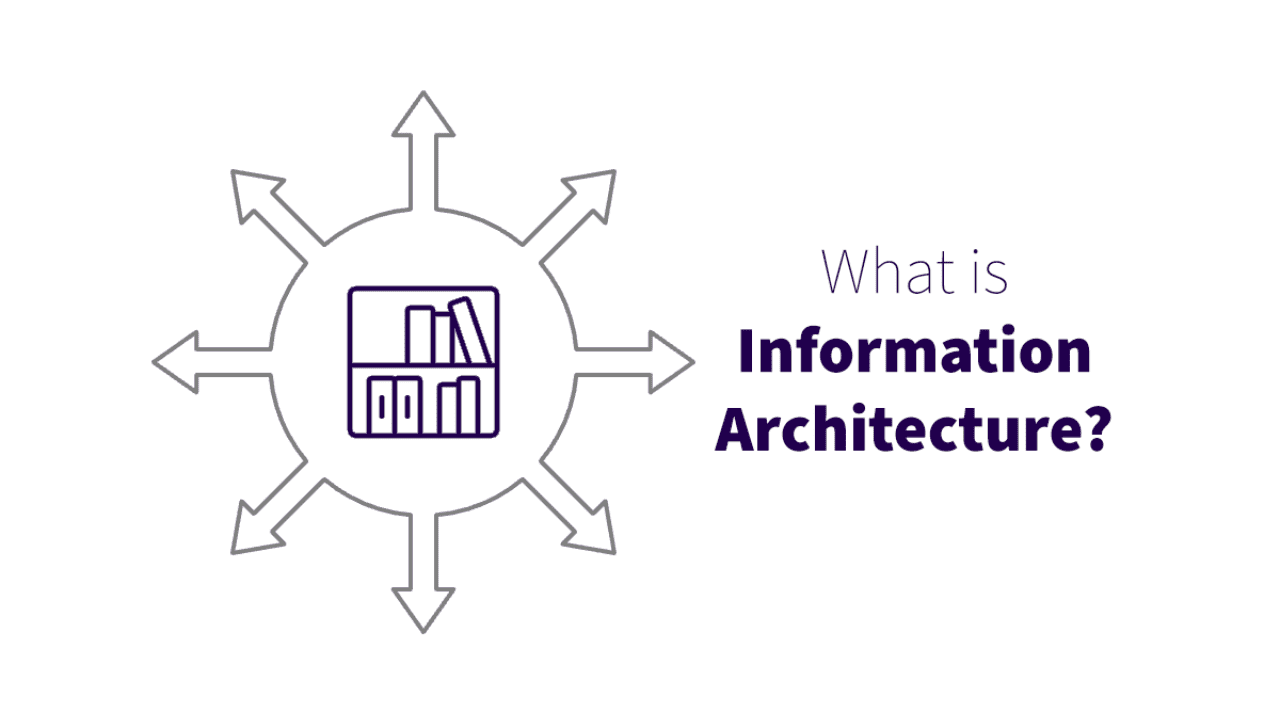What is Information Architecture?
File folders and SharePoint sites can grow wild, like an unkempt lawn. Information architecture is like a good landscaping plan. And, just like a good landscaping plan, well-thought-out information does a lot more than make your Microsoft 365 environment beautiful – it also makes it easier to spend time and do activities in. Good information architecture also makes regulatory compliance much easier – just think of the regulators as your homeowner’s association.

What is information architecture?
Information architecture is the technical term for all the structural rules that dictate how your data is stored and organized.
Information architecture comes from many places – from the way you set up your file storage and sharing tools to the instructions you give new hires. It’s formed by leadership decisions as well as by the habits and actions of every team member at your organization.
Information architecture can’t account for every possibility, but you can follow information architecture best practices and guide your employees to do the same. The results will benefit everyone.
Why should business leaders care about information architecture?
Healthy information architecture aids with:
- Consistency – information is stored in the same way every time, in places that make sense
- Ease of findability – you, your employees, and auditors can independently and intuitively locate the information they need
- Productivity – employees spend less time searching for files and recreating documents they don’t realize already exist
- Less employee stress – guidance about how to store information makes decisions easier
- Regulatory compliance – information is stored in a way that obeys laws and regulations, making you less vulnerable
- Flexibility – when information is stored consistently, it’s easier to add, move, or remove information
- Security – consistently stored information is easier to keep secure
- Information life cycles – it’s simpler to retain information for a certain period and archive it after a certain amount of time has passed, and easier to manage what happens to information when an employee leaves the organization
Information architecture examples in the Microsoft 365 environment
Digital culture
Digital culture is the way you represent and develop your organization’s values, working style, and overall culture through the technology your employees use. You wouldn’t want your employees to work in a dark, depressing, and disorganized office, right? Your technology is your organization’s virtual office.
An example of digital culture is visually differentiating the pages of your intranet with brand-compliant images that reflect the page content. This helps employees navigate your intranet more easily, and gives the pages personalities that employees can relate to and remember.
Read more about digital culture.
Navigation
Without navigation, it’s hard for anyone at your organization to find their way. Navigation is one of the most commonly overlooked components of Microsoft SharePoint, because Microsoft doesn’t automatically build a navigation bar for you.
An example of navigation in information architecture is making sure a hub site links back to your main intranet. It’s crucial to give users a way to get back to the intranet – if they’re lost, they can escape to somewhere that’s familiar to try again.
Naming conventions
Naming conventions are rules that govern how people at your organization name and organize files, folders, and SharePoint sites. Without naming conventions, every employee does things their own idiosyncratic way, leading to clusters of files with names that only make sense to one or two people. This makes it hard to find documents, which leads to stress, poor compliance, and duplicated work when people remake a file they think doesn’t exist.
An example of a naming convention is a rule to name sites and folders after departments or topics, not after people. Naming your customer service site Customer Service makes it much clearer what the site is for than naming it after Drew, the head of customer service. New employees won’t know who Drew is, and if Drew leaves the organization the site will make even less sense.
Learn more about naming conventions.
Scoping of sites and channels
Choosing between Teams channels, Teams, SharePoint libraries, SharePoint sites, and so on, is scoping. Scoping is all about knowing when to use which part of the Microsoft 365 environment. Every organization’s scoping needs are different, but every organization needs good scoping – without it, your employees will have trouble finding the information and files they need, wasting their time and leaving you at risk of failing an audit.
One scoping strategy is thinking about the life cycle of the information you’re storing – that is, how long the data will be relevant. For example, you might create a Team for a type of recurring event your organization throws called Fundraisers, and then a channel within that team for a specific event called 2024 Charity Walk. There are many strategies depending on the specific information you’ll be storing.
Permissions
Permissions settings control who can view, edit, and otherwise interact with documents in Teams and SharePoint. They are indispensable for security and compliance. But did you know they also affect the loading/processing speed of your tenant?
One permissions best practice is to think about permissions at the beginning whenever building anything new in Microsoft 365. The way that you set up permissions shapes the structure of the Teams channel or SharePoint site!
Content types and metadata
Metadata – information attached to files that adds context – makes a lot of people nervous. They don’t know how to add or access it, and it seems too complicated to them. But Microsoft has made adding metadata to your business processes quite simple. And you can harness metadata to make information easier to find, organize, and even automate [link to IT automation blog post].
One popular application of metadata is to use it to show statuses in an approvals process. You can create a status field with labels like “Draft”, “Needs approval,” and “Approved”, and then group files in a SharePoint folder by status to instantly see which documents are at which stage of the process. You can also create metadata for priority status (from “back burner” to “burningly urgent”) or client name/type.
How healthy is your information architecture?
Does your organization’s information architecture feel like a neat and productive garden, or more like a chaotic tangle of invasive weeds?
If you’re closer to weeds territory, Wellington Street Consulting can work with you and your team to map out your current information architecture, clear the chaos, and build sustainable, convenient information architecture to make everyone’s job easier. We’re not scared of your messy or nonexistent information architecture – we’ve seen it all.
If your Microsoft 365 tenant is closer to garden status– congratulations. You’re already doing better than most organizations. But there’s always room for improvement. If you have robust metadata, your organization is a good candidate for automating complex business/IT processes.
Either way, the first step to cleaning up or improving your organization’s information architecture is to book a discovery call with Wellington Street Consulting. We charge a flat fee to explore your Microsoft 365 tenant for issues, resolve smaller problems, and give you a strategic plan and estimate for additional work. We create a snapshot of your O365 tenant to help you see everything at a high level.







